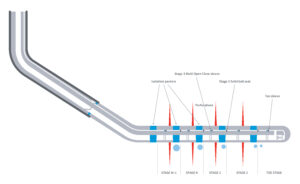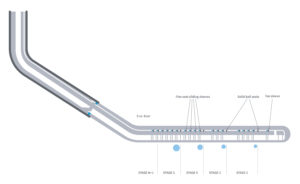North Sea wells prove efficiency, function of multistage ball-actuated, sleeve-based stimulation system
System incorporated dissolvable frac balls and provided multi-open-close functionality; success in two trial wells led to fieldwide implementation
By Catherine Mehus, Tore Sørheim, Petter Lønning, Tom Rune Koløy and Stephen Forrester, National Oilwell Varco
Wells in the North Sea that require multistage fracturing have typically used cemented plug-and-perf completions. Although this method is widely used due to historical precedent, its stimulation effects can sometimes underdeliver. The process is also time consuming, with typical turnaround times per stage varying from three to seven days for North Sea projects. Excessive operational time negatively impacts both project economics and well payback times. As a result, National Oilwell Varco (NOV) designed the i-Frac systems.
A major operator in the North Sea was using a standard stimulation technique that involved cluster perforations of 10 holes every ±250 ft for its completion campaign. Acid was bullheaded at 40-60 bbl/min, and ball sealers were used for mechanical diversion between clusters. Using this method meant that limited-entry stimulation designs could not be achieved.
Wells were completed with five to eight clusters per stimulation stage, which led to a large amount of acid dissolving the chalk in the upper clusters of each stage, typically in the shallower clusters. This dissolved chalk around the wellbore in such shallow clusters removed support for the casing, which allowed the pipe to buckle into the large caverns created.
The operator attempted several solutions to this problem. First, single-shot perforations were used to try and improve acid treatment and distribute perforations evenly across the reservoir. Selective acid stimulation using coiled tubing and straddle packers was also attempted. Finally, “smart” wells that used downhole and surface equipment were tried.
Ultimately, all of these methods proved time-consuming, expensive and unable to address the operator’s needs. The operator approached NOV to determine if ball-drop sliding sleeves could provide improved results. The primary objectives for the system were set as optimized perforation spacing and significant operational time savings. A secondary objective was to eliminate some well control issues associated with previous technologies.
Shift from smart well technology

The operator had installed a significant number of surface-controlled smart well systems in the field. Such completions were designed to have both sleeves and packers installed in a cemented and tubing-conveyed perforated 7 ⅝-in. reservoir liner. Surface-controlled valves in each stage would allow multistage well stimulation, production management and zonal restimulation capabilities. Problematically, the cost of such systems in well campaigns was prohibitively high due to the investment required in downhole and surface hardware and the additional rig time necessary to complete the wells. Many such wells also experienced early failure and loss of functionality.
The operator worked with NOV to determine a mechanical alternative to the smart well systems. The operator decided that a ball-actuated, sleeve-based system with multi-open-close (MOC) functionality would be a compromise that would eliminate the need for more smart wells. There were no functional limitations to this plan, as stimulation could still be achieved without intervention by dropping balls from surface. Although individual zones would require a wireline tractor intervention for reservoir management and restimulation, such a process was considered as having a high enough success rate to merit its inclusion. Lack of significant data, however, was a concern for the mechanical solution.
NOV designed the i-Frac family of ball drop-activated sliding sleeves to deliver increased functionality and reduced cost. The solution components are all run in the closed position and opened by dropping dissolving balls from surface:
• MOC sliding sleeve – a full stimulation, production and injection sleeve that can be mechanically manipulated multiple times with a standard shifting tool during the lifecycle of the well to isolate unwanted production or perform individual zone re-stimulation;
• Open-close sliding sleeve – a sleeve that can be shifted to closed position with a standard shifting tool to isolate unwanted production;
• Single-shot sliding sleeve – a sleeve that remains in the open position after the ball drop during the stimulation phase.
Dissolvable balls for the sliding sleeves were the other critical component of this operation. Extensive differential pressure and dissolving testing revealed that, in this instance, the optimum ball would be able to
withstand the impact when opening multiple sliding sleeves; have differential pressure ratings at a minimum 8,000 psi for six hours at 70°C; be able to dissolve in various fluid and temperature combinations; and dissolve at an optimized rate. The operator indicated that beyond functionality enhancements and cost reductions, life-of-well flexibility for water shutoff and restimulation of zones were desired outcomes of using the new technology.
After completion of a validation testing program, the sliding-sleeve systems were installed as part of two trial wells and later implemented as part of a fieldwide project for the operator.
Case History – Trial Wells

The operator’s primary purposes for integrating stimulation sliding sleeves into the operation were to divide and isolate the reservoir into manageable stimulation intervals and provide even acid distribution at each interval. The chosen sliding sleeve was designed to be run in hole in the closed position as part of a reservoir liner. The liner could be placed in the reservoir with open-hole packers as a means of creating desired stimulation stages or could be cemented in place using conventional liner-running and cementing procedures.
Two trial wells, detailed below, were completed based on the operator’s desire to adapt sliding-sleeve technology to increase efficiencies.
Well 1
The first well used the ball drop-activated sliding-sleeve system, with the reservoir liner being made up with 73 sleeves that were run to depth and cemented in place as part of a 5-in. reservoir liner in a 6 ½-in. hole. The 73 sleeves were split in four stimulation stages, and the flow area of the sleeves was tailored using a limited-entry design, ensuring proper distribution of acid within each stage and over the entire stage at high pumping rates.
The liner was cemented with a foamed cement slurry and standard operational cementing practices. After pumping the cement down the well, there was good indication of the liner wiper plugs landing in the collar at expected volumes. Additionally, there were no pressure indications as the cement wiper dart passed through the ball-drop-activated sliding sleeve seats. Issues with a third-party hydraulic sleeve, however, yielded unexpected problems, and a coiled-tubing run was necessary to clean out the excess barite. Despite this setback, a total of 56 sleeves across the next three zones were opened and stimulated successfully by ball-drop operations.
Well 2
The efficiency experienced during stimulation of the first well prompted the operator to complete and stimulate a second trial well. The second well was a 17,000-ft horizontal oil producer, which was completed using 39 sleeves run across two stages.
After makeup and installation, cementing darts were pumped and landed at theoretical displacement volume, and a successful pressure test to 5,000 psi was conducted. Building on the lessons learned from the first well, a cleanout run was preplanned and carried out.
A 3 ⅜-in. ball was dropped to open the 19 sleeves in the lower stage, with the ball landing in the lower seat and providing isolation to the lower perforations during the acid matrix stimulations. Subsequently, a 3 ⅝-in. ball was dropped to open the 20 sleeves in the upper stage. The ball landed in the lower seat of the upper stage and provided isolation of the previous stage during the acid stimulation. Repeating this process yielded individual stimulation for each stage. Additionally, a good water-hammer effect was seen immediately after hard shutdown, indicating proper stimulation. High oil production with very little drawdown was encountered in both stages of the completion, as well as increased operational efficiency and a reduced need for intervention operations.
More than 34 additional wells in new field developments over the past three years have further proven the efficacy of using the sliding-sleeve method for reservoir completions.
Fieldwide implementation results

Implementation of the sliding-sleeve system yielded substantial performance improvements across several categories.
Completion Efficiency
Installation time and operational risk were significantly reduced through fewer operations using stimulation sleeves as opposed to conventional plug and perf. Using the sliding-sleeve systems eliminated the need to handle perforating gun explosives on the rig, and the barrier qualifications for the sleeves allowed the operator to run the completion in conventional inhibited drill water instead of weighted brine. The need for a deep-set barrier plug was also eliminated.
Stimulation Efficiency
The trial wells and subsequent well campaigns have proven that interventionless multizone stimulations are more time- and cost-efficient than conventional methods. Current plug-and-perf technology can typically take three to seven days per stage in the North Sea. For the operator, a seven-stage well stimulation was performed within 36 hours with the liner-in-liner system. The cemented four-stage liner system was stimulated within 48 hours, including one vessel change-out. Longer stimulation campaigns that use plug and perf are also more susceptible to meteorological and environmental hazards.
The introduction of dissolvable frac balls to the North Sea also provided the operator with better results. Compared with the conventional composite frac balls, dissolvable frac balls reduced the risk of blocking production from a zone below and of balls obstructing later intervention operations.
Production Management
The ability to close and reopen the stimulation sleeves after the initial well stimulation has allowed unwanted production from high water-cut zones to be closed and for selective multizone restimulation. A well completed with the liner-in-liner system with three zones was installed with water- and oil-triggered tracer systems in each compartment to identify the contribution from each zone.
Effective identification and isolation of the water-producing zone proved the robustness of the completion system as a production management tool. Additionally, use of the MOC sleeve allowed for restimulation to increase production performance.
A stimulation methodology involving use of selective zonal isolation from the toe of the well and up was applicable to wells with more stimulation sleeve stages. In those instances, the possibility of stimulating isolated zones separately will yield more benefit than a conventional bullhead stimulation of the whole well in one run.
Multistage ball-drop frac systems have been proven time efficient through interventionless well stimulations. The stimulation sleeve products, systems and procedures have become, over several years, a preferred well completion solution in one of the North Sea’s largest oilfields. As the oil and gas industry in the North Sea continues to change, further development of innovative completion and production solutions will drive even greater improvements to efficiency and performance. DC




